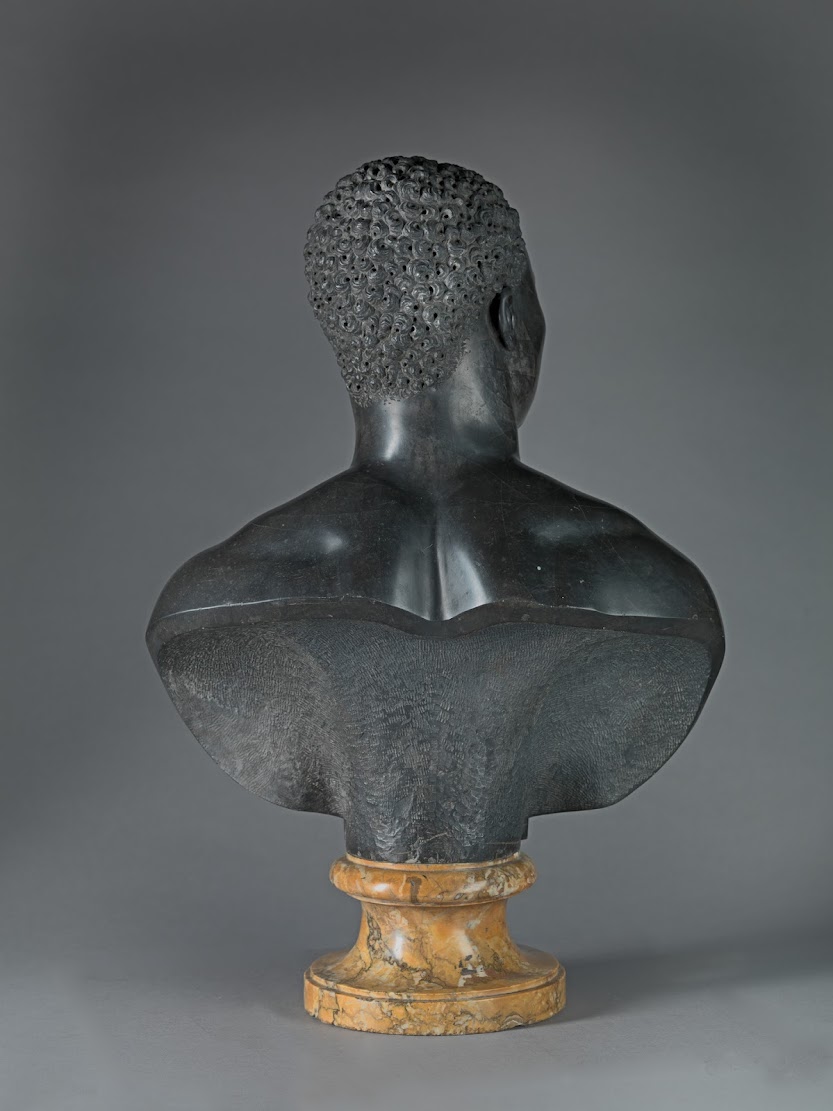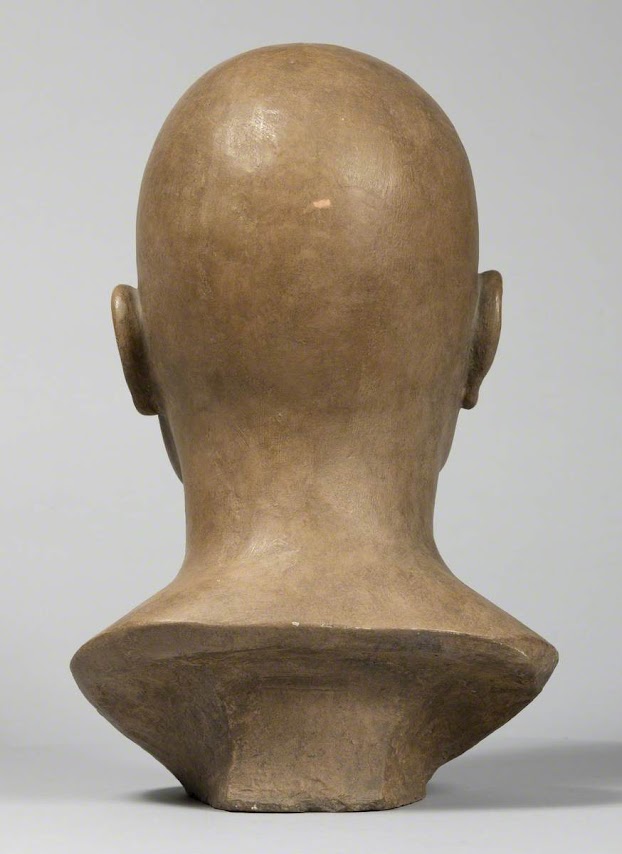This post under construction.
Updated 4 Dec 2024 - to be continued. I have been meaning to do this for a long time.
Bust of a Moor.
Attributed to Francis Harwood (1727 - 83).
Working in Italy mainly in Florence from 1752 until he died.
Patinated Plaster.
A Life Mask / Head and Upper Torso
Height 65 cms.
A recent discovery.
Sold by - Auctioneers Pandolfini Casa d'Aste, Florence. Italy.
Lot 101 on June 30, 2020.
https://www.pandolfini.it/uk/auction-0340/toscana-secolo-xviii-12020002941
Where is it now??
In the absence of any more high resolution photographs - it would appear that this bust is the prototype for the two busts below, but at this point I cannot be 100% sure - the scar on the forehead is not visible and there are real differences in the hair.
These differences in the hair can probably be accounted for because when making the plaster piece mould the sitters hair would have needed to be protected (probably by some sort of grease) in order to prevent the hair being caught in the setting plaster.
....................
What to me is plainly obvious is that this bust has been taken from life - the closed eyes suggest that a mould was created around the head and shoulders of the model and a cast then taken.
In order to make the marble busts the eyes would have had to be remodelled and carved but the bust and the rest of the head could be relatively easily transferred to the marble with the aid of a pointing machine.
It is my belief that Roubiliac would have used this method on more than one occasion.
Bust of a Black Man
c. 1758.
Black limestone (pietra di paragone) on a yellow Siena
marble socle.
Overall: 28 × 20 × 10 1/2 inches (71.1 × 50.8 × 26.7 cm
Yale Center for British Art, Paul Mellon Collection
The centre website is rather vague on the provenance of this
remarkable bust.
Before Paul Mellon bought it in 1967, the Yale bust had been
part of the Esterhazy Collection in Vienna, where it was misattributed to the
Renaissance artist Alessandro Vittoria (1525–1608) and called “The Blackamoor”,
and in 2006 it became part of the Yale Center for British Art collection.
"This remarkable bust may be a portrait: details such as the
small scar on the man’s forehead and the subtle depressions in the skin around
his temples, nose, and eyes suggest close study of an individual sitter.
However, the sculptor Francis Harwood, who was based in Italy, specialized in
making copies of classical statues for sale to English Grand Tourists, and so
it is also possible that this is a copy or adaptation of an Antique model."
"A third possibility is that the bust was made as an
allegorical image of “Africa.” A passage from Joseph Baretti’s "Guide
through the Royal Academy" (London, 1781) suggests that, by 1781,
Harwood’s "Bust of a Man"—or something very similar—had entered the
cast and sculpture collection of the Royal Academy. Though we cannot be sure
that Baretti is referring to the sculpture on display here, his description
suggests that works like it may have been difficult to categorize even in the
eighteenth century: AFRICUS.
"For want of a better, I give this name to a Head of a
Blackamoor, which is in the Niche of this Room.
A Friend of mine would have it called Boccar, or Boccor, an
African King named in one of Juvenal’s Satires. But, as it has no ensigns of
Royalty about it, I imagine it to be a Portrait of some Slave, if not a
fanciful performance intended to characterise the general Look of the African
faces.
Whatever it be, I think it a fine thing of the kind".
In the nineteenth century, Harwood’s bust was mistakenly
believed to be a portrait of an athlete named Psyche in the service of the
first Duke of Northumberland".
Another version of this sculpture, which bears Harwood’s
signature and the date 1758, is now at the J. Paul Getty Museum.
Text above lifted from the Yale Centre for British Art website
In light of the appearence of the plaster bust it would seem some of this needs to be reappraised
https://www.britishartstudies.ac.uk/index/article-index/bust-of-a-man/issue/issue-1/page/1
http://pdf.britishartstudies.ac.uk/Issues/issue-1.pdf
http://idiscoveredamerica.com/?p=52
http://idiscoveredamerica.com/?p=149
http://idiscoveredamerica.com/?p=292
Photographs of the two busts shown here side by side for
comparison.
The details of the ear make it clear that these busts are of
the same man.
It would seem fairly obvious to me that the detail of the
new scar on the forehead would suggest that the Yale bust is the original and
that the Getty bust is a later version.
The scar on the Yale bust clearly shows the stitch marks
which have healed over in the Getty bust.
the hair on the Yale bust has much deeper drilling and the
curls are much more defined.
The early history and provenance of both of these busts is
unclear.
It has been suggested that the date on the Getty bust has
been recut, but the inscribed signature is close to that on other busts such as
the Sotheby's Caracalla.
The date of 1758 on the Getty busts implies that it was
sculpted in Italy.
_________________________________
Bust of A Man
at the J Paul Getty Museum
http://www.getty.edu/art/collection/objects/1199/francis-harwood-bust-of-a-man-english-1758/?
see also, for a rather verbose article on the two busts:
The surface of this bust has undergone at least one program of restoration - the Getty "conservation work and analysis shows that the bust’s original, eighteenth-century coating was a medium, translucent brown.
In
fact, conservators have in recent years removed much of the thickly applied
black paint, wax, and shellac that had been applied to the bust in the 1980s,
in an attempt to bring the surface colour closer to the varied texture and tone
of the underlying marble".
"With noble bearing, this man proudly holds his chin
high above his powerful chest. Sculptor Francis Harwood chose a black stone to
reproduce the sitter's skin tone. Harwood also chose an unusual antique format
for the bust, terminating it in a wide arc below the man's pectoral muscles.
Harwood was familiar with antique sculptures from time spent in Florence
reproducing and copying them. He may have deliberately used this elegant,
rounded termination, which includes the entire, unclothed chest and shoulders,
to evoke associations with ancient busts of notable men. Although the identity
of the sitter is unknown, the scar on his face suggests that this is a portrait
of a specific individual. This work may be one of the earliest sculpted
portraits of a Black individual by a European".
___________________
Provenance:
1786 - 1817: possibly Hugh Percy, second duke of Northumberland, English, 1742 - 1817, possibly by inheritance to his son, Hugh Percy.
1817 - 1847: possibly Hugh Percy, third duke of Northumberland, English, 1785 - 1847, possibly by inheritance to his brother, Algernon Percy.
1847 - 1865: Algernon Percy, Fourth duke of Northumberland, English, 1792 - 1865 (Stanwick Hall, Yorkshire, England)
Described in the 1865 after-death inventory of
Stanwick Hall as "a fine bust in black marble - W. Richmond the pugilist -
on Italian Marble Plinth."
1865 - 1922
Percy Family, English (Stanwick Hall, Yorkshire, England) [sold, Anderson and Garland, Stanwick Hall, Yorkshire, May (no day), 1922, lot 189] - description of lot 189 as "A Carved Black Marble Bust of a Negro, 27 in. high, by F. Harwood, on circular Sienna marble plinth and wood pedestal, 4ft, high (in the margin in black ink is indicated the amount of 2.10 pounds)
Before 1987 Private Collection (England) [sold, Christie's, London, April 9, 1987, lot 83 to Cyril Humphris]
1987 - 1988 - Cyril Humphris, S.A. (London, England), sold to the J. Paul Getty Museum, 1988.
......................
Of Tangential Relevance -
This dropped into my in box from John Sullivan on 4 Dec 2024.
I thought that this was the most relevant place to save it.



















































